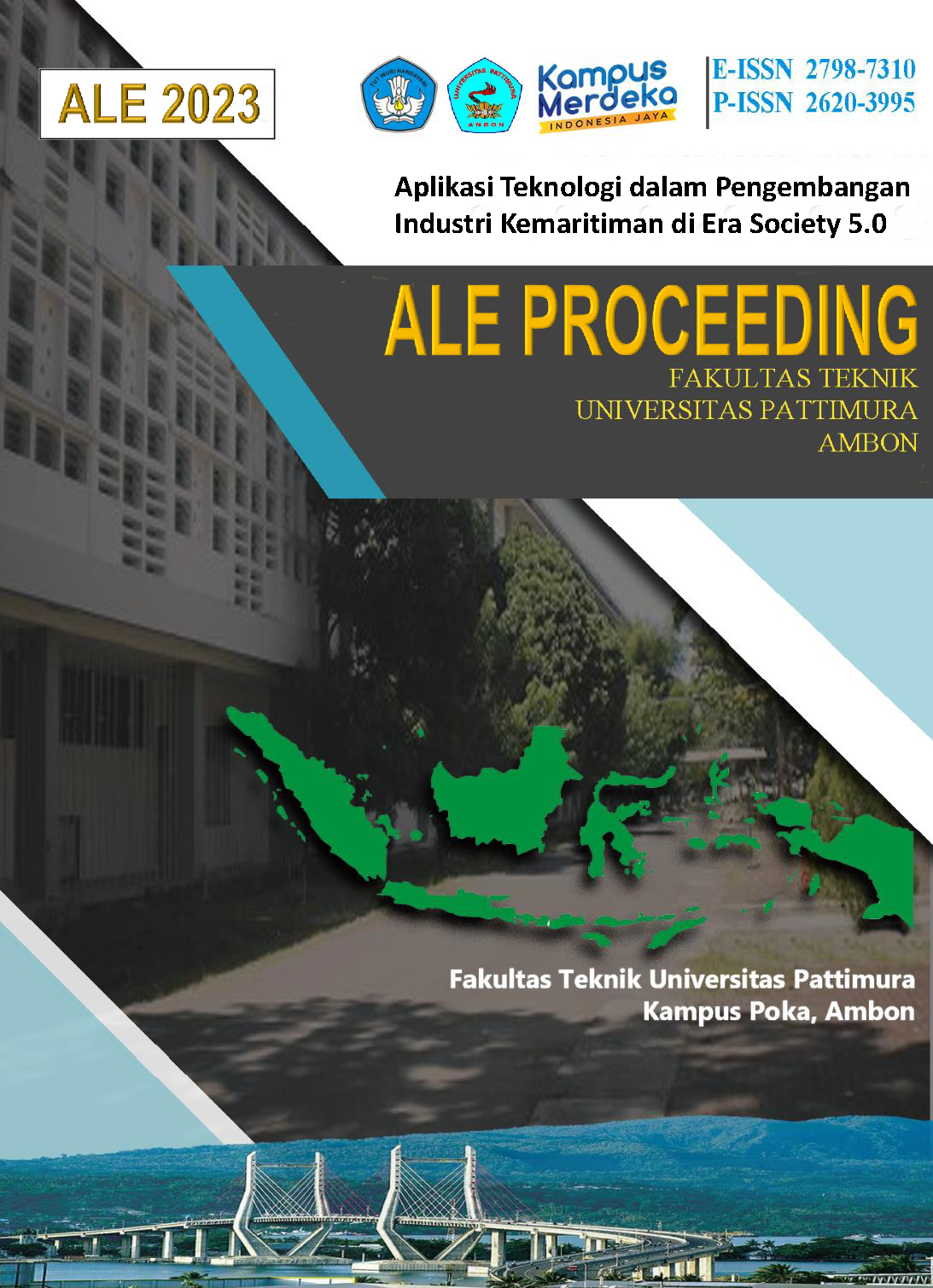STUDI REGIM ALIRAN FLUIDA DAN PENENTUAN HEAD LOSS AKIBAT GESEKAN PADA INSTALASI PERPIPAAN
Abstract
Instalasi perpipaan dalam industry merupakan sistem keteknikan memegang perananan penting yang berfungsi untuk mengalirkan air, minyak dan gas dari satu titik ke titik lain melalui semua komponen yang tercakup didalamnya. Sistem perpipaan terdiri dari pipa lurus, sambungan-sambungan, belokan katup-katup dan peralatan-peralatan instrumentasi yang harus bekerja secara optimal. Regim aliran fluida di dalam berbagai komponen perpipaan memberikan pengaruh terhadap aliran teristimewa pada dua parameter penting yaitu koefesien gesek dan kehilangan head. Tujuan penelitian ini adalah memantau sifat pergerakan fluida dalam rezim laminar dan turbulen dan menentukan nilai head loss sebagai fungsi debit dalam rezim laminar dan turbulen. Penelitian dilakukan pada pipa lurus berdiamater 4 inci dengan panjang total 10 meter, diameter 4 inci dengan satu belokan 90o. Penentuan hubungan kerugian head terhadap debit dilakukan melalui simulasi hidrodinamika, dimana kecepatan aliran divariasi dari 0,02 - 0,1 m/s, sesuai dengan debit Q = 10-52 liter/menit. Variasi kecepatan ini melewati regim aliran laminar dan turbulen yang diukur pada 4 penampang pada pipa lurus dan elbow. Hasil yang diperoleh menunjukan bahwa profil aliran pada setiap penampang berbeda-bada untuk nilai debit Q yang sama. Pada setiap penampang dengan variasi nilai debit Q, karakter nilai kerugian head meningkat dengan meningkatnya debit aliran Q dengan nilai berbeda pada setiap penampang, namun trend perubahannya mirip. Kondisi laminar terjadi pada Q <34 lit/menit dengan kerugian head hdl < 0,74x10-3 m, transisi terjadi pada Q=34-36 lit/menit, dengan hdl = (0,74 -0,68)x10-3 m dan turbulen sepenuhnya pada Q>36 lit/menit dengan hdl > 0,74x10-3 m. Hal ini menujukan bahwa pada elbow atau belokan, aliran akan menjadi turbulen walaupun pada kecepatan yang rendah.
Downloads
References
M. Suarda and I. G. K. Dwijana, “Kajian Pemasangan Pipa Air Bersih Melayang dalam Air Laut untuk Mendukung Perkembangan Pariwisata di Nusa Ceningan dan Lembongan,” J. Energi Dan Manufaktur, vol. 13, no. 1, p. 15, 2020, doi: 10.24843/jem.2020.v13.i01.p03.
W. M. Rumaherang, C. F. Refwalu, C. S. E. Tupamahu, S. J. E. Sarwuna, and E. J. Rumaherang, “EVALUASI KINERJA POMPA SENTRIFUGAL BERKAPASITAS 600 KL/Hr PADA SISTEM PEMOMPAAN MINYAK,” J. Tek. Mesin, Elektro, Inform. Kelaut. dan Sains, vol. 3, no. 1, pp. 17–27, 2023, doi: 10.30598/metiks.2023.3.1.17-27.
R. Dindorf, J. Takosoglu, and P. Wos, “Advances in fluid power systems,” Energies, vol. 14, no. 24, 2021, doi: 10.3390/en14248589.
W. M. Rumaherang, “Perhitungan aliran dan peramalan karakteristik pompa sentrifugal bertingkat dengan penggunaan CAD blade’s system,” J. Ilm. Tek. Mesin CAKRAM, vol. 2, no. 2, pp. 69–76, 2008.
W. Wang, X. Wang, Z. Wang, M. Ni, and C. Yang, “Analysis of internal flow characteristics of a startup pump turbine at the lowest head under no-load conditions,” J. Mar. Sci. Eng., vol. 9, no. 12, 2021, doi: 10.3390/jmse9121360.
A. Hatumessen, N. Titahelu, and C. S. Tupamahu, “Analisis Efektivitas Penukar Kalor Pipa Helikal Destilasi Minyak Atsiri Kayu Putih,” ALE Proceeding, vol. 4, pp. 127–132, 2021, doi: 10.30598/ale.4.2021.127-132.
N. Titahelu, D. S. Pelupessy, C. S. E. Tupamahu, and A. F. Rumagutawan, “Meningkatkan Efektivitas Kondensor Vertikal Pipa Helikal Koil Untuk Destilasi Minyak Atsiri Sereh,” J. Rekayasa Mesin, vol. 14, no. 1, pp. 235–249, 2023, doi: 10.21776/jrm.v14i1.1219.
I. Dwi Arirohman et al., “Studi Karakteristik Pola Aliran Stratified pada Pipa Horizontal 16 mm,” J. Sci. Technol. Virtual Sci., vol. 1, no. 1, pp. 9–15, 2021.
T. G. I. Rumaherang W.M., “Расчет кавитационного обтекания рабочего колеса радиально - осевой гидротурбины © 2011,” Samara Fed. Res. Sci. Cent. Russ. Acad. Sci. (SamSC RAS), vol. 1, no. 2, pp. 472–475, 2011, [Online]. Available: https://cyberleninka.ru/article/n/raschet-kavitatsionnogo-obtekaniya-rabochego-kolesa-radialno-osevoy-gidroturbiny
W. M. Rumaherang, J. Louhenapessy, M. F. Noya, and C. S. Tupamahu, “Studi Eksperimental Performance Kavitasi Waterjet Propulsi,” ALE Proceeding, vol. 4, pp. 112–120, 2021, doi: 10.30598/ale.4.2021.112-120.
Department of Energy Fundamentals, “Thermodynamics , Heat Transfer , and Fluid Flow Volume 1 of 3 DOE Fundamentals Handbook,” Energy, vol. 1, no. June, p. 138, 1992.
A. Marali, S. Wahyudi, and N. Hamidi, “Analisa Fluida Nano Al2O3-Air pada Alat Penukar Kalor Proses Pendinginan (Metode Simulasi),” Re TII, pp. 413–418, 2017.
P. Rahayu, D. K. Putri, and N. Indriyani, “Pengaruh Diameter Pipa Pada Aliran Fluida Terhadap Nilai Head Loss,” J. Agit., vol. 2, no. 2, pp. 2776–513, 2021.
A. A. Hanieh, FLUID POWER CONTROL, Second Edi. Jerusalem, 2021.
E. Busquets and M. Ivantysynova, “A Multi-Actuator Displacement-Controlled System with Pump Switching – A Study of the Architecture and Actuator-Level Control,” JFPS Int. J. Fluid Power Syst., vol. 8, no. February, pp. 66–75, 2015.
M. P. Schultz and K. A. Flack, “Reynolds-number scaling of turbulent channel flow,” Phys. Fluids, vol. 25, no. 2, 2013, doi: 10.1063/1.4791606.
D. B. DeGraaff and J. K. Eaton, “Reynolds-number scaling of the flat-plate turbulent boundary layer,” J. Fluid Mech, no. 422, pp. 319–346, 2000.
and M. S. C. J. P. Monty, N. Hutchins, H. G. H. Ng, I. Marusic, “A comparison of turbulent pipe, channel and boundary layer flows,” J. Fluid Mech, vol. 632, pp. 431–442, 2009.
Y. M. Choo, J. G. Kim, and S. H. Park, “A study on the friction factor and reynolds number relationship for flow in smooth and rough channels,” Water (Switzerland), vol. 13, no. 12, 2021, doi: 10.3390/w13121714.
Nurnawaty and Sumardi, “NALISIS PERUBAHAN TINGGI TEKANAN AKIBAT SUDUT BELOKAN 900 DAN 450 DENGAN MENGGUNAKAN FLUID FRICTION APPARATUS,” J. Tek. Hidro, vol. 13, no. 1, pp. 28–37, 2020, [Online]. Available: https://journal.unismuh.ac.id/index.php/hidro/article/viewFile/3980/2716
A. Priyati, S. H. Abdullah, and K. Hafiz, “Analisis Head Losses Akibat Belokan Pipa 90° (Sambungan Vertikal) Dengan Pemasangan Tube Bundle,” J. Ilm. Rekayasa Pertan. dan Biosist., vol. 7, no. 1, pp. 95–104, 2019, doi: 10.29303/jrpb.v7i1.104.
S. Wahyudi dan Agung Sugeng Widodo, “Analisis Aliran Fluida Dua Fase (Udara-Air) melalui Belokan 45 o,” J. Rekayasa Mesin, vol. 5, no. 3, pp. 217–224, 2014.
E. Widodo and R. Y. Pradhana, “Analysis of pipe diameter variation in axial pumps for reducing head loss,” IOP Conf. Ser. Mater. Sci. Eng., vol. 403, no. 1, 2018, doi: 10.1088/1757-899X/403/1/012029.
Y. A. Cengel and J. M. Cimbala, Fluid-Mechanics-Fundamentals-and-Applications-3Rd-Edition-Cengel-and-Cimbala-2014. 2014.
Е. С. Санкович, А. Б. Сухоцкий, И. Гидропривод, and Л. Практикум, Гидравлика и гидропривод.
N. D. Katopodes, “Free-Surface Flow, Environmental Fluid Mechanics,” in Butterworth-Heinemann, 2019, pp. 2–98. doi: https://doi.org/10.1016/B978-0-12-815489-2.00001-0.
Y. N. Lee and R. L. Johnston, Surface Process, Transportation, and Storage Volume 4 in Oil and Gas Chemistry Management Series, Chapter 5. Gulf Professional Publishing: Gulf Professional Publishing, 2023. [Online]. Available: https://www.sciencedirect.com/science/article/abs/pii/B9780128238912000053?via%3Dihub
W. M. Rumaherang and J. Latuny, “Fluid Flow Study in Various Shapes and Sizes of Horizontal Axis Sea Current Turbine,” Sinergi, vol. 25, no. 3, p. 289, 2021, doi: 10.22441/sinergi.2021.3.006.
V. Uruba, “On Reynolds number physical interpretation,” AIP Conf. Proc., vol. 2000, no. December, 2018, doi: 10.1063/1.5049926.
M. A. Kabir, M. F. Alam, and M. A. Uddin, “A numerical study on the effects of reynolds number on blood flow with spiral velocity through regular arterial stenosis,” Chiang Mai J. Sci., vol. 45, no. 6, pp. 2515–2527, 2018.
A. Y. Lipovka and Y. L. Lipovka, “Determining Hydraulic Friction Factor for Pipeline Systems,” J. Sib. Fed. Univ. Eng. Technol., vol. 1, no. 7, p. 62, 2014.
M. P. Schultz and K. A. Flack, “The rough-wall turbulent boundary layer from the hydraulically smooth to the fully rough regime,” J. Fluid Mech., vol. 580, no. June, pp. 381–405, 2007, doi: 10.1017/S0022112007005502.
K. Madlener, B. Frey, and H. K. Ciezki, “Generalized reynolds number for non-newtonian fluids,” vol. 1, pp. 237–250, 2009, doi: 10.1051/eucass/200901237.
O. E. Turgut, M. Asker, and M. T. Çoban, “A review of non iterative friction factor correlations for the calculation of pressure drop in pipes,” Bitlis Eren Univ. J. Sci. Technol., vol. 4, no. 1, 2014, doi: 10.17678/beujst.90203.
Copyright (c) 2023 Edwina Jerusalem Rumaherang, W. M. E. Wattimena, Sesilia M. Rawulun, Excelsis Noya

This work is licensed under a Creative Commons Attribution-ShareAlike 4.0 International License.
An author who publishes in the ALE Proceeding agrees to the following terms:
- Author retains the copyright and grants ALE Proceeding the right of first publication of the work simultaneously licensed under the Creative Commons Attribution-ShareAlike 4.0 License that allows others to share the work with an acknowledgment of the work's authorship and initial publication in this journal.
- Author is able to enter into separate, additional contractual arrangements for the non-exclusive distribution of the journal's published version of the work (e.g., post it to an institutional repository or publish it in a book) with the acknowledgment of its initial publication in this journal.
- Author is permitted and encouraged to post his/her work online (e.g., in institutional repositories or on their website) prior to and during the submission process, as it can lead to productive exchanges, as well as earlier and greater citation of the published work (See The Effect of Open Access).
Read more about the Creative Commons Attribution-ShareAlike 4.0 Licence here: https://creativecommons.org/licenses/by-sa/4.0/.






